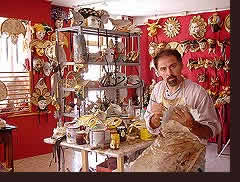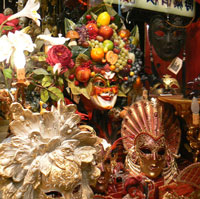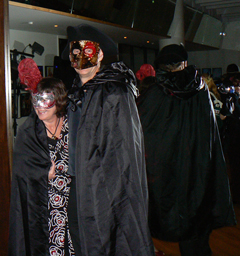All About Masks
Here is some background on these beautiful works of art:
- History
- How the masks are made
- Care of your mask
- Authenticity
- Types of masks
- Commedia dell'Arte
- Venice Carnival
History of the Venetian Masks
How the masks are made
 The making and wearing of Italian masks became so widespread that mask-makers have had their own official artisan status in Italy since the 15th century. Today, our artisans still make their masks completely by hand from the beginning of the process to the end.
The making and wearing of Italian masks became so widespread that mask-makers have had their own official artisan status in Italy since the 15th century. Today, our artisans still make their masks completely by hand from the beginning of the process to the end.Firstly a clay mould is created, which then has liquid plaster poured into it. When this plaster layer is completely hardened, the original clay mould is removed. The plaster (negative) mould is covered with a thin layer of Vaseline and then filled with several layers of wet paper and glue. Great care is taken to press the paper into the mould without wrinkling or creasing. After this the mould is placed on a heat source until the mask is dry and can be taken out. Then several coats of white tempera are applied and the eye holes can be cut out.
 Now the mask is ready to be decorated with different kinds of materials. Masks are decorated with bright colours, gold and silver leaf, feathers, fabrics, macrame’, Swarovski crystal and leather.
Now the mask is ready to be decorated with different kinds of materials. Masks are decorated with bright colours, gold and silver leaf, feathers, fabrics, macrame’, Swarovski crystal and leather.These masks are sold in many parts of Venice and add to the color and excitement of this ancient town by recalling days when they were woven into the fabric of society.
It is our pleasure to share a touch of Venetian tradition and color with you, and we hope you like our collection of Italian masks.
back to top
Care of your Mask
Venetian Masks are quite durable and easy to care for with some basic guidelines. Following these guidelines will allow you to enjoy your mask for many years:- Keep the mask away from direct sunlight, sources of heat or humidity
- To keep the mask looking in top condition, the best thing is to dust it frequently if it is on display, using a dry cloth or duster.
- Never use detergents or abrasive cleaners on the mask.
Authenticity
There are many cheap imitations out there, but ALL of our masks are imported directly from Venice in Italy and come with either a stamp of authenticity on the inside of the mask or a certificate of authenticity from the manufacturer in Venice.back to top
Types of Mask
There are many classic designs of Masquerade Masks and Venetian Masks including Jolly/ Joker Masks, Colombine Masks, Bauta Masks, Volto Masks and a number of Traditional Designs.
Bauta Masks
The Bauta is a mask which covers the whole face, with a stubborn chin line, no mouth, and lots of gilding.
The Bauta was introduced in the 16th Century and was worn by the upper classes in Venetian society frequently during the year, but by the masses during the Carnival. Today it is a popular purchase as it can be a free standing decoration as a feature in home decor, or a stunning party mask. The fashion was to wear it with a black tricorno (three pointed Venetian hat), zendale (long hood made of satin and macrame) and long cape.
A feature of the Bauta is that it conceals the identity but enables the wearer to talk and eat or drink easily. It tends to be the main type of mask worn during the Carnival. It was used also on many other occasions as a device for hiding the wearer's identity and social status. It would permit the wearer to act more freely in cases where he or she wanted to interact with other members of the society outside the bounds of identity and everyday convention. It was thus useful for a variety of purposes, some of them illicit or criminal, others just personal, such as romantic encounters.
Because of the shape of the Bauta mask it can stand upright on its own and so can be displayed easily on furniture or any flat surface. It is also popular for something different to wear to a masquerade ball or masked ball. Wearing an Italian masquerade mask to one of these events will attract many admiring comments!
Commedia dell'Arte
Commedia dell'Arte (translated as "the comedy of artists"), is a form of improvisational theater that began in Italy in the 16th century and held its popularity through the 18th century. It is still performed today. Performances were unscripted, held outside and used few props. They were free to watch and funded by donations. A troupe consisted of ten people, including eight men and two women.
Conventional plot lines were written on themes of adultery, jealousy, old age and love. Many of the basic plot elements can be traced back to Roman comedies of Plautus and Terence, some of which themselves were translations of lost Greek comedies of the fourth century BC. Performers made use of well-rehearsed jokes and stock physical gags, known as "lazzi" and "concetti", as well as, ofources, on the spot improvised and interpolated episodes and routines, called burle (jokes), usually involving a practical joke. Since the productions were improvised, dialogue and action could easily be changed to satirize local scandals, current events or regional tastes, while still using old jokes and punch lines. Characters were identified by costumes, masks and even propos, such as a type of baton known as a "slapstick" (hence the modern term "slapstick comedy"). These characters included the forebears of the modern clown, namely Harlequin (English for arlecchino) and Zanni.
The classical, traditional plot is that the innamorati are in love and wish to be married, but one elder (vecchio) or several elders (vecchi) are stopping this from happening, leading the lovers to ask one or more zanni (eccentric servants) for help. Typically the story ends happily, with the marriage of the innamorati and forgiveness for any wrong doings. There are countless variations on this story, as well as many that diverge wholly from the structure, such as the well known story about Arlecchino becoming mysteriously pregnant, or the Punch and Judy scenario.
back to top
The Venetian Carnival
All over Italy you'll find the tradition of the Carnival, the feasting celebrating the last "hurrah" before the beginning of Lent. However, Venice (Venezia) is certainly the carnival city 'par excellence'. Every year for two weeks, the city is taken over by the 'il Carnevale' and shows and parties spill one after the other around the streets and canals, night and day. Thousands of people wear beautiful masks and amazing costumes and dance in the streets and piazza(s) and also ride in the traditional gondola. The climax of the event comes on the final day, the Mardi Gras, when carnival fever is at it's peak and everyone has fun and for at least one day, forgets about the troubles of everyday life. Check for details of this year's carnival here.
back to top

